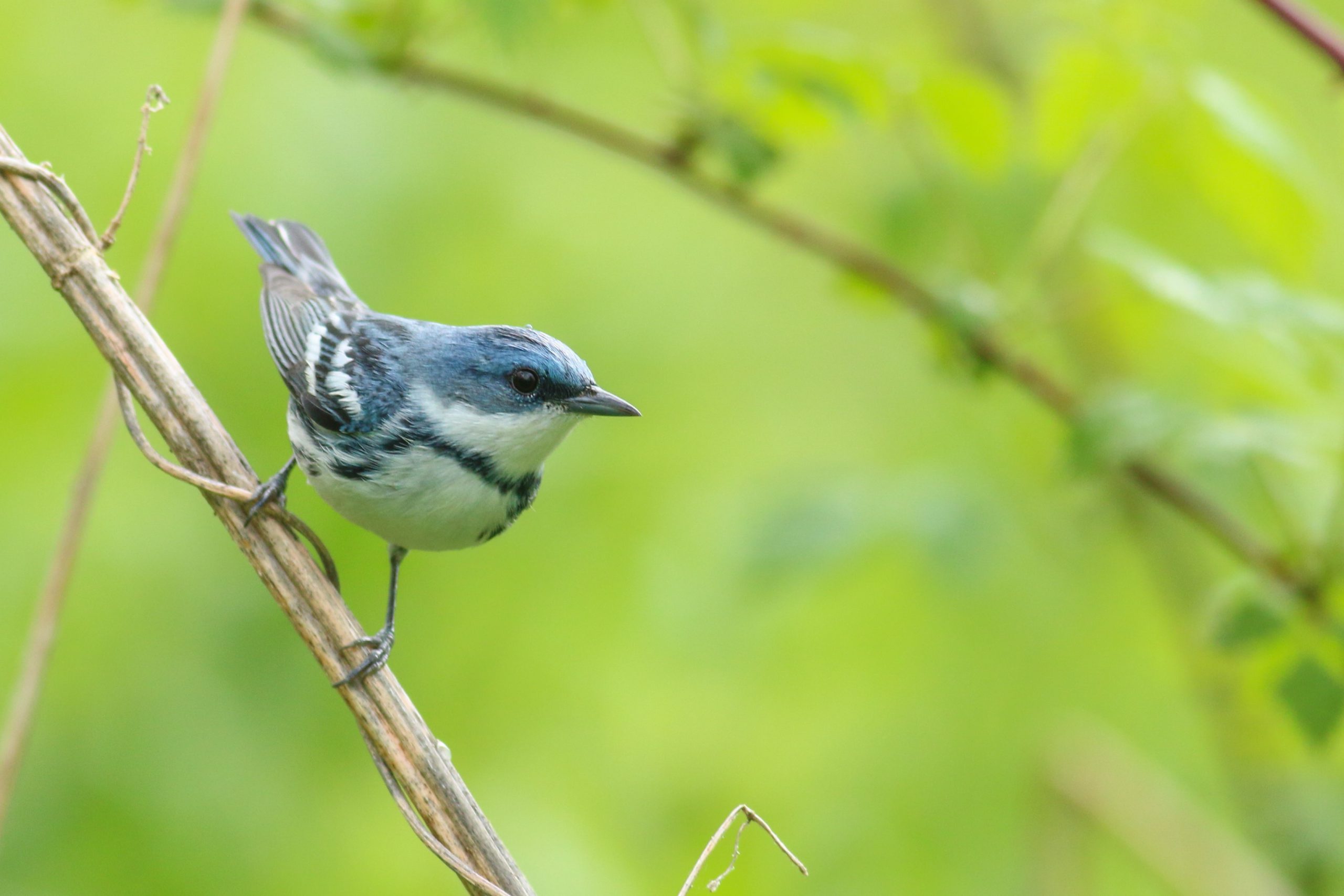Cerulean Warbler
Setophaga cerulea
COSEWIC status: Endangered
Estimated Canadian Population (individuals): 1000
Appearance and population trend
Cerulean Warblers are small songbirds with long wings and short tails. As their name suggests, the males are cerulean blue with a white underside and a blue collar along the breast. The females are bluish-green with an overall yellow wash. Continental estimates from 1970 to 2014 show a 72% population decline for Cerulean Warblers (Partners in Flight 2017). In Ontario, they have declined 16% over a 10-year period, though southwestern Ontario shows a 27% decline over the same period (Francis 2007).
Location and habitat
Canada’s Cerulean Warbler population is mainly clustered in Ontario’s Frontenac Arch, which is predicted to hold 55% to 65% of the Canadian breeding population (COSEWIC 2010). A smaller breeding population can be found in the Carolinian region of southwestern Ontario. Cerulean Warblers live in mature forests that either have high canopies; or contain several large trees composed largely of maples, oaks, and hickory, surrounded by smaller trees (Jones & Robertson 2001). Males use open canopies and forest edges to help project their songs for potential mates and rivals. They prefer to nest in hardwoods about 17.7 m high with an average nest height of 11.4 metres above the ground (Oliarnyk & Robertson 1996).
Threats
Agricultural and housing development causes the loss of entire habitats or creates extensive forest fragmentation in both breeding and wintering grounds.
What Birds Canada is doing
The Ontario Forest Birds at Risk (OFBAR) program prioritizes the habitat requirements of Cerulean Warbler. The two regions they inhabit have a different forest structure. Silviculture management decisions incorporate best management practices and guidelines when they take local forest structure into account. Cerulean Warblers act as an umbrella species, meaning that protecting Cerulean Warblers will, in turn, protect other species that make up the ecological community of deciduous forests.
Best Management Practices (BMP) for Cerulean Warblers
- Do not harvest between the beginning of May to the end of July.
- When harvesting, retain full canopy trees with a diameter of 38 cm or more. Keep forest’s even age and diverse species structure.
- Keep canopy gaps of 40 to 100 m2.
- Do not create gaps or harvest in closed canopies forests that are suitable for Acadian Flycatchers.
- If in the Carolinian forests, it is not recommended to do light to moderate group selection for harvest.
Interesting facts
Cerulean Warblers are often heard instead of seen. The males have a buzzy song ending in a trill. The mnemonic for their song is “Poor-poor-Pitiful-me”.
Cerulean Warblers overwinter on the eastern slopes of the Northern Andes, one of the most threatened habitats in the world. They have been shown to thrive in shade-grown coffee plantations.
Hybridization has been known to occur between Cerulean Warblers and other species. The most recent example, a Cerulean Warbler x Northern Parula hybrid was discovered in Northeastern Ohio in 2014.
References
COSEWIC. 2010. COSEWIC assessment and status report on the Cerulean Warbler Dendroica cerulea in Canada. Committee on the Status of Endangered Wildlife in Canada. Ottawa. x + 40 pp. (www.sararegistry.gc.ca/status/status_e.cfm)
Francis, C. M. 2007. Cerulean Warbler. Pp. 500-501 in M. D. Cadman, D. A. Sutherland, G. G. Beck, D. Lepage, and A. R. Couturier (eds.). Atlas of the Breeding Birds of Ontario, 2001-2005. Bird Studies Canada, Environment Canada, Ontario Field Ornithologists, Ontario Ministry of Natural Resources, and Ontario Nature, Toronto, xxii + 706 pp.
Jones, J. and R. J. Robertson. 2001. Territory and nest-site selection of Cerulean Warblers in eastern Ontario. The Auk. 118:727–735.
Partners in Flight. 2017. Avian Conservation Assessment Database. 2017.
Oliarnyk, C. J. and Robertson, R. J. 1996. Breeding behavior and reproductive success of Cerulean Warblers in southeastern Ontario. The Wilson Bulletin. 673-684.
Species at Risk Profiles

Acadian Flycatcher
Endangered

Louisiana Waterthrush
Threatened

Prothonotary Warbler
Endangered

Red-headed Woodpecker
Endangered

